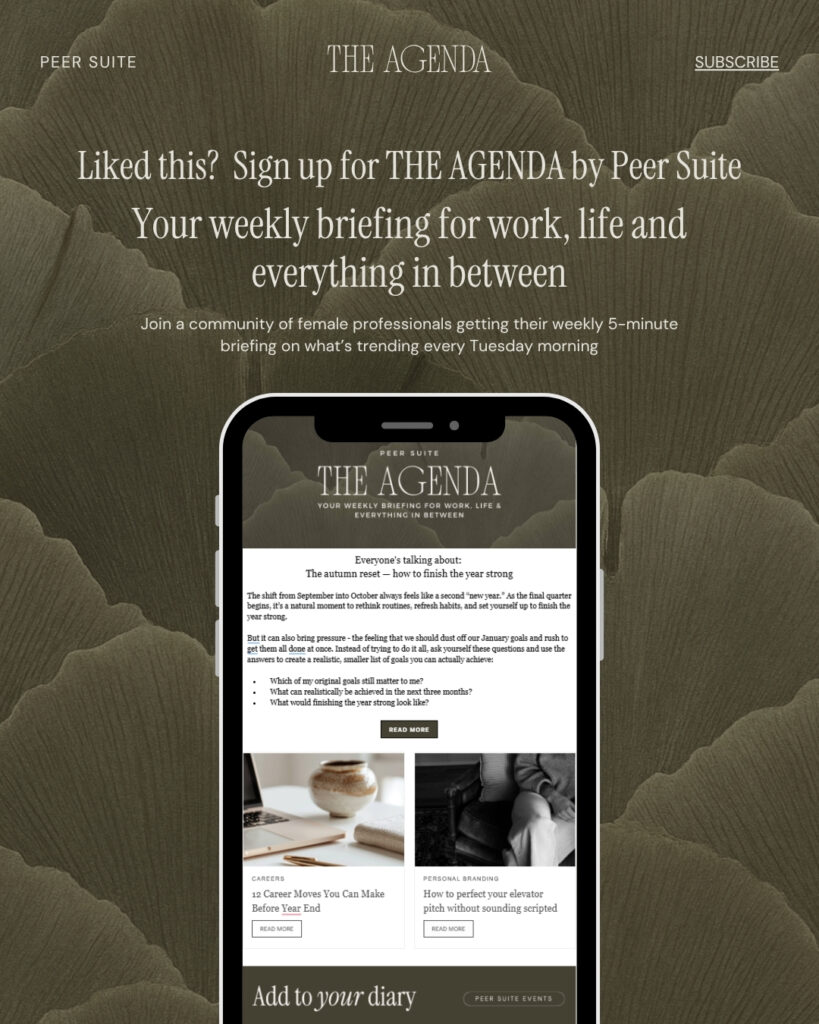Remember when we were told that loyalty was the key to career success? Stay with one company for a decade, put your head down, work hard, and eventually you’ll get that promotion and raise you deserve. But here’s what that advice often delivers instead: watching colleagues leap ahead while you’re stuck at 3% annual raises, seeing external hires brought in at higher levels, and realizing your unwavering loyalty may not be getting you the career progression and results you have been seeking.
If you’ve ever felt the frustration of career stagnation despite your dedication and hard work, you’re not alone. Many professional women find themselves trapped in a cycle of waiting for recognition, waiting for that promised promotion, waiting for someone else to advocate for their advancement.
Enter the 4×6 method: a strategic framework that puts you back in the driver’s seat of your career trajectory. Coined by TikTok career strategist Ladan Nia, this approach moves job changes from reactive decisions into intentional career moves that can accelerate your growth and maximize your earning potential.
What Is the 4×6 Method?
Here’s how it works: instead of staying in a role indefinitely hoping for advancement, you commit to a two-year strategic cycle at each position, broken into four distinct six-month sprints. Each sprint has a specific purpose designed to extract maximum value from the role while building your skills, reputation, and marketability.
This is about approaching your career with the same strategic planning that companies use for their business objectives, the goal isn’t job hopping, rather executing a deliberate growth strategy.
And here’s why it works: research shows that job changers typically see salary increases of ~10%, when they move to a new company. Compare that to the average 3-4% annual raise for staying put, and the math becomes compelling. Over a decade, this difference compounds dramatically, potentially representing hundreds of thousands of dollars in lifetime earnings.
The method also prevents one of the most insidious career killers: the comfort trap. By establishing an end date from day one, you maintain the hunger and interest in the role that often dulls after years in the same position. And you will never become complacent because you’re always building toward something bigger.
The Four Sprint Breakdown
Sprint 1 (Months 1-6): Learn & Absorb
Your first six months in your new (or even existing) position are about building a foundation of knowledge and relationships. This is your time to become a sponge, absorbing everything about your role, the company culture, and the ecosystem you’re operating in.
What success looks like:
- Understanding organizational dynamics and identifying key stakeholders, partners, and board members
- Mapping out who holds influence and how decisions really get made (often different from the org chart)
- Learning what the company values and prioritizes in practice, not just in mission statements
- Building genuine relationships across departments and levels
- Observing what behaviors and results get rewarded and promoted
Action steps:
Create a stakeholder map within your first month. Identify not just your direct reports and manager, but who influences budgets, who champions new initiatives, and who has the CEO’s ear. Understanding power dynamics early helps you navigate more effectively.
Schedule coffee chats strategically. Don’t just network within your department. Connect with people in finance, operations, marketing, and leadership. Ask about their roles, challenges, and what they wish other departments understood about their work. These relationships become invaluable later.
Document everything. Keep a running list of company values you observe in action, recurring challenges teams face, and gaps you notice. This intelligence will fuel your innovation in Sprint 3.
Understand the true culture. Notice what gets celebrated in all-hands meetings, which projects receive resources, and what complaints get dismissed versus addressed. This tells you what the company truly cares about, regardless of what’s written on the website.
The key during this phase is restraint. You’re not here to prove you’re the smartest person in the room or to immediately start changing things. You’re here to understand the landscape so deeply that when you do make moves, they’re strategically sound.

Sprint 2 (Months 7-12): Master & Excel
You’ve learned the ropes. Now it’s time to become exceptional at your core responsibilities. This phase is about mastering your role to the point where excellence becomes effortless – where you can perform your duties in your sleep and consistently exceed expectations.
What success looks like:
- Executing your responsibilities with consistent excellence
- Building efficient systems and processes that demonstrate your organisational thinking
- Becoming the go-to expert others turn to for your area of expertise
- Anticipating problems before they arise and solving them proactively
- Delivering results that make your manager look good
Action steps :
Create efficiency systems that showcase your strategic thinking. Don’t just complete tasks – optimize how they’re done. Document your processes, create templates, build frameworks that others can follow. This demonstrates leadership thinking even in an individual contributor role.
Track your wins obsessively. Keep a detailed record of every project completed, problem solved, metric improved, and positive feedback received. Note specific numbers: “increased efficiency by 23%,” “reduced turnaround time from 5 days to 2 days,” “saved the company £50K in vendor costs.” These concrete achievements become negotiation gold later. Use the Peer Suite Career Tracker for this
Exceed expectations consistently, but strategically. You want to be known as someone who delivers exceptional work, but don’t burn yourself out doing everyone else’s job. Set boundaries while demonstrating excellence within your scope.
Start building your reputation beyond your immediate team. Volunteer for cross-functional projects, share insights in team meetings, and position yourself as a valuable contributor to broader company goals.
The mastery phase is where many people get comfortable and stop pushing. Don’t fall into that trap. Yes, you should absolutely celebrate becoming excellent at your role, but remember this is not the final stage in your career development in this role and there are two more sprints to go!

Sprint 3 (Months 13-18): Innovate & Impact
Now that you’ve mastered the fundamentals, it’s time to leave your mark. This is where you take everything you’ve learned and apply it to create something new – whether that’s defining new processes, breaking into new markets, solving a persistent challenge, or leading an initiative that moves the needle.
What success looks like:
- Leading a high-visibility project that demonstrates your strategic thinking
- Implementing process improvements that create lasting value
- Solving a problem that’s been bothering the team or company
- Mentoring or developing others, showcasing leadership capability
- Quantifying your impact with concrete metrics and results
Action steps:
Identify the innovation opportunity you mapped in Sprint 1. Remember those gaps and challenges you documented when you first started? Now’s the time to propose solutions. You have the credibility, knowledge, and relationships to execute.
Frame your innovations as business solutions, not just ideas. Don’t just suggest something new – show how it solves a specific problem, saves money, drives revenue, or improves efficiency. Connect your proposal to company priorities and speak the language of leadership.
Lead, don’t just contribute. This is your chance to step into a leadership role, even if you don’t have direct reports. Volunteer to spearhead the initiative, coordinate stakeholders, and drive results. Leadership experience at any level strengthens your resume and negotiation position.
Document your impact religiously. Take before-and-after metrics. Collect testimonials from colleagues and stakeholders. Create a narrative around the change you drove and the results you delivered. This becomes the centerpiece of your next job search.
For professional women, this phase is particularly crucial. Women are often overlooked for promotions when they’re seen as excellent executors but not innovators or leaders. This sprint intentionally positions you as someone who drives change and creates value, not just maintains the status quo.
Remember: you’re not innovating for innovation’s sake. You’re strategically building a portfolio of leadership experiences and measurable impact that will command a higher salary and better title at your next role.

Sprint 4 (Months 19-24): Search & Negotiate
This is where the 4×6 method reveals its brilliance. Instead of waiting until you’re burned out or desperate to start looking, you begin your job search while you’re still thriving in your current role. You dedicate six months to finding your next opportunity, and you do it from a position of strength.
What success looks like:
- Having an updated resume highlighting your recent, quantifiable achievements
- Networking strategically without desperation (at a Peer Suite event)
- Interviewing with confidence because you’re still employed
- Negotiating from a position of strength rather than need
- Landing a role with meaningful advancement in title, compensation, or responsibility
Action steps:
Update your LinkedIn profile immediately. Don’t wait until month 19 – start optimizing your profile now. Highlight your innovations from Sprint 3, add skills, request recommendations, and start engaging with industry content. Build your visibility before you need it.
Network strategically, not frantically. You’re not desperately looking – you’re exploring opportunities. Reach out to former colleagues, attend industry events, join professional associations. Let people know you’re open to conversations about the next phase of your career.
Practice negotiation in low-stakes situations. Start having conversations about compensation early in your search process, even with opportunities you’re not seriously considering. This builds your comfort level and helps you refine your pitch before the offer you really want comes along.
Know your market value and don’t undersell yourself. Research what people in similar roles at your experience level are earning. Use sites like Glassdoor, Levels.fyi, and Payscale, talk to recruiters, join salary transparency communities.
The six-month timeline is deliberately generous. You can be selective, wait for the right opportunity, and walk away from offers that don’t meet your standards.
When you receive offers, negotiate. Women are less likely to negotiate than men, and when we do, we ask for less. Here’s your secret weapon: after following the 4X6 method you now have two years of documented, quantified achievements, you’re currently employed, and you know exactly what value you bring!

Why This Method Works
The 4×6 method is particularly powerful for professional women because it directly addresses several systemic challenges we face in the workplace.
It eliminates the loyalty penalty. Research consistently shows that company loyalty disproportionately disadvantages women. We’re socialized to be grateful, accommodating, and patient. We wait for recognition rather than demanding it. We believe that hard work will eventually be noticed and rewarded. Meanwhile, our male counterparts negotiate aggressively and move strategically, often outpacing us even when we’re outperforming them. The 4×6 method gives you permission to prioritize your growth over company loyalty.
It creates built-in negotiation leverage. By the time you’re job searching, you have 18 months of achievements, innovations, and proven results. You’re not hoping someone will see your potential – you’re demonstrating your established value. This is particularly important for women, who are often hired and promoted based on proven track record while men are advanced based on potential.
It prevents the “wait and hope” trap. How many times have you been told “your time will come” or “we’re working on it” when you’ve asked about advancement? The 4×6 method means you’re never waiting for someone else to advocate for you. You’re actively creating your next opportunity.
It builds a diverse skill set. Every two years, you’re exposed to new industries, methodologies, teams, and challenges. This diversity makes you more marketable and valuable. You’re not pigeonholed as “the person who only knows how this one company does things.”
It maintains your competitive edge. The method ensures you never become complacent. This keeps your skills sharp and your energy high -qualities that fade when you’ve been in the same role too long.
Most importantly, the 4×6 method forces you to see yourself as the CEO of your own career. You’re not an employee hoping for scraps of advancement, instead you are calculated moves to maximize your growth and compensation.
Addressing Common Concerns
Let’s tackle the questions and worries that inevitably surface when considering this approach.
“Won’t I look like a job hopper?”
This is usually the first concern, and it’s valid -except that two years is the sweet spot. It’s long enough to demonstrate stability and make meaningful contributions, but short enough to maintain momentum.
When you tell your career story in interviews, focus on the narrative: each move was intentional for specific growth. “I joined Company X to build my expertise in Y, then moved to Company Z to lead larger initiatives in that space, and now I’m looking to take on an even more senior role where I can drive strategic direction.”
Hiring managers respect strategic career planning. What they’re suspicious of is patterns that suggest problems: lateral moves without progression, leaving after three months, or narratives that don’t make sense.
Frame your moves around accumulated skills and increasing responsibilities, not restlessness. Each role should represent a step up in some meaningful way- title, compensation, scope, industry prestige, or leadership responsibility.
“What about pension matching, benefits and equity vesting?”
This is a practical concern that requires math so run the actual numbers. If you’re getting a 10% salary increase by moving let’s say from £60K to £66K, that’s an extra £6,000 per year.
Most UK workplace pensions vest immediately, but compare employer contribution rates. If you’re receiving higher employer contributions in your current role versus a new role that matters. Factor this into total compensation and negotiate accordingly.
Look for companies with more favourable terms overall. Immediate pension matching, shorter equity vesting periods, and flexible benefits packages are becoming more common, particularly in tech and scale-ups.
Factor everything into negotiation conversations. Leaving unvested shares, a guaranteed bonus, or enhanced benefits behind? That’s leverage when discussing sign-on bonuses or equity packages. Many companies will offer a “golden hello” to compensate for what you’re forfeiting.
Staying somewhere primarily because of benefits vesting is the definition of “golden handcuffs.” Calculate whether those handcuffs are actually worth what you’re giving up in growth and earnings. Often, two or three strategic moves with 10% increases each will far outweigh a few thousand pounds in deferred benefits.
“I feel guilty leaving after two years”
Let’s reframe this completely. You’re not abandoning anyone. You’re not betraying trust. You’re making a professional decision about your career path, exactly as companies make decisions about their business needs.
Companies benefit from employee turnover. Fresh perspectives prevent groupthink. Competitive job markets push organizations to improve their practices. You staying somewhere out of guilt while your career suffers doesn’t help anyone.
Moreover, you’ve delivered 18 months of high-value work. After your learning period in Sprint 1, you’ve given the company a year and a half of peak performance, innovation, and results which is a fair exchange.
The guilt often comes from gendered expectations that women should prioritize others’ needs over their own advancement. Recognize that conditioning for what it is and choose differently.

When the 4×6 Method May NOT Be Right for You
Strategic career planning means knowing when the strategy doesn’t fit your situation. The 4×6 method is a great way to approach your career, but it’s not universally applicable.
Skip the method if you’re genuinely on a growth trajectory. If you’re receiving real promotions, meaningful raises, and expanding responsibilities every 12-18 months, and you’re satisfied with the pace, stay. If your current company is investing in your development and you have a clear path to leadership roles you want, there’s no reason to leave. The key word is “genuine”, not promises of future advancement, but actual progression happening now.
Reconsider if you’re building significant equity. If you’re at a company where equity could be life-changing – whether that’s pre-IPO stock options, or ownership stake in a growing business -the math changes. Run the numbers comparing potential equity value against salary increases from moving. Sometimes the equity play is the smarter bet if you believe in the business.
Pause if you’re in a highly specialized field with limited opportunities. Some industries and specializations have fewer open roles, and relationships matter more than in broad markets. In academia, niche scientific research, or highly specialized technical fields, strategic staying might be wiser than strategic moving.
Question the method if you’re prioritizing work-life balance over rapid advancement. The 4×6 method is designed for ambitious acceleration. If you’re in a season of life where stability, predictability, and balance matter more than climbing the ladder quickly, that’s a valid choice.
Wait if you recently relocated for your current role. If you moved across the country for this position less than a year ago, jumping after two years might create financial strain or personal instability that outweighs career gains. Factor in your whole life situation.
The most important thing is honest self-assessment. Are you defending staying because you’re genuinely in the right place, or because you’re afraid of change? Only you can answer that – but be truthful with yourself.
Implementing Your 4×6 Strategy
Ready to take control of your career trajectory? Here’s how to start.
Before You Begin
Audit your current position. Where are you in the cycle right now? If you’ve been in your role for three years, you’re past due for a move. If you started six months ago, you’re in Sprint 1 – focus on learning. Understanding your starting point determines your immediate action steps.
Set clear financial and career goals. Where do you want to be in two years? Four years? Six years? What salary range? What level of leadership? What type of work? Get specific. “I want to earn £120K in a senior manager role leading a team of 5+ in the tech industry within four years” is a goal you can plan around.
Build an emergency fund. Having 3-6 months of expenses saved gives you confidence and allows you to job search from a position of strength. That financial cushion allows you to be selective and walk away from opportunities that don’t meet your standards.
Start developing your personal brand now. Update LinkedIn. Start sharing insights in your industry. Build your network. Establish expertise. Your reputation should be growing continuously, not scrambled together when you need it.
Success Metrics to Track
Don’t just execute the strategy – measure your progress.
Salary progression percentage. Track your total compensation increases over time. Are you meeting the 10% per move benchmark? If not, are you gaining in other valuable ways like equity, title, or scope?
New skills acquired. Maintain a running list of technical skills, soft skills, tools, methodologies, and experiences you’re adding. Diversity of skills increases marketability.
Leadership experiences. Document every time you lead a project, mentor someone, coordinate stakeholders, or drive decision-making. Leadership track record is what commands senior-level compensation.
Network expansion. Are you building relationships across industries and companies? Is your professional network growing in quality and diversity? A strong network multiplies opportunities.
Industry reputation. Are you known in your field? Are people seeking your input? Are you being invited to speak, write, or contribute? Reputation creates inbound opportunities.
These metrics tell you whether your strategy is working or needs adjustment.
Taking Control of Your Career Trajectory
The 4×6 method represents a fundamental shift in how you view your career. You’re not a passenger hoping someone else drives you to success. You’re the architect of your professional life, making deliberate decisions based on strategic planning rather than reacting to whatever opportunities happen to land in front of you.
The traditional career advice was written for a different era – one where companies offered pensions, loyalty was rewarded, and staying put for decades made sense. In many industries and companies, that world doesn’t exist anymore. Companies will restructure, downsize, and pivot without hesitation when it serves their interests. You should approach your career with the same clear-eyed strategic thinking.
This doesn’t mean you shouldn’t offer any loyalty to the company you work for – you can bring your full self to every role, build genuine relationships, and do meaningful work while also recognizing that your career progression is your responsibility, not your employer’s.
For professional women especially, this mindset shift is key. We’ve been taught to wait our turn, prove ourselves twice as much, and hope someone notices our contributions. The 4×6 method says: stop waiting, stop hoping and start executing.
Your career is a series of deliberate moves, each one building on the last, each one moving you closer to your ultimate goals. Two years is enough time to make real impact and not enough time to stagnate. It’s enough time to master a role and not enough time to become complacent.
Your Next Steps
If you’re ready to take control of your career:
- Assess where you are right now. How long have you been in your current role? Which sprint phase are you in? What would success look like in your next phase?
- Create your 2-year plan. Map out your four sprints. What do you need to learn? Master? Innovate? What would your ideal next role look like?
- Start documenting immediately. Begin tracking your achievements, building your wins list, and quantifying your impact. This is the foundation of everything that follows.
- Build your support system. Find mentors, join professional networks, connect with other ambitious women executing similar strategies. Community makes this journey sustainable.
- Take the first action today. Update your LinkedIn profile. Schedule a coffee chat. Document one achievement. Research salary ranges for your next role. Small action creates momentum.
Your career is too important to leave to chance. You’ve worked too hard and have too much talent to stay stuck in a holding pattern. The 4×6 method gives you a framework to channel your ambition into tangible results.
The best time to start was two years ago, the second best time is today!
Additional Resources
4×6 Career Planning Worksheet
- Current role assessment and sprint identification
- Goals for each upcoming sprint phase
- Achievement tracking template
- Network building checklist
Interview Script: Explaining Strategic Career Moves “I’m very intentional about my career progression. I joined [Company X] specifically to develop my expertise in [skill/area], and over two years I successfully [specific achievement]. I’m now looking for a role where I can [next level goal], which is why I’m excited about this opportunity at [Company Y].”
Achievements Documentation Framework
- Situation: What was the challenge or context?
- Action: What specific actions did you take?
- Result: What measurable outcome did you achieve?
- Value: How did this benefit the company/team?
Negotiation Conversation Starters
- “Based on my research of market rates for this role and my experience level, I was expecting a range of [X to Y]. Can we discuss closing that gap?”
- “I’m very excited about this opportunity. To make this work financially, I’d need to be at [target number]. Is there flexibility in the salary band?”
- “Given that I’m leaving behind [specific benefits/equity], I’d like to discuss a sign-on bonus to help bridge that gap.”

06
Oct
